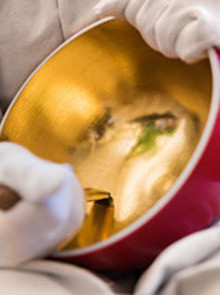Following the so-called “white kiln” and the rigorous inspection (and occasional adjustment or correction) of the fired pieces at the “sorting workshop”, various decorative crafts can adorn the porcelain with colours and/or precious metals.
Les couleurs de Sèvres, fabriquées dans son laboratoire, se divisent principalement en deux catégories : les couleurs dites de grand feu (cuisson au-dessus de 1 100 Manufactured at the on-site laboratory, Sèvres’ colours can be divided into two main categories: high-fire colours (fired above 1,100° C), composed of stains and vitreous fluxes, and low-fire colours (fired below 1,000° C), made up of stains and fondants, also manufactured on-site. Sèvres’ most commonly used precious metal is pure 24-carat gold, made from an ingot powdered at the laboratory. Various stages of decoration alternate according to ever lower firings.
Sèvres is home to a diversity of crafts dedicated to porcelain adornment, namely: enamelling via insufflation, calling upon various techniques using high-fire colours; the application of coloured foundations, the most famous of which is Sèvres blue, using low-fire colours; offsetting; printing, craft preceded by engraving and drafting/modelling; spinning and gilding, for the application by brush of fillets and other garnitures; burnishing, in which agate and hematite tools are used to polish gilded designs, thereby rendering matt gold brilliant again after firing; and mounting-chiselling, in which metals are worked, notably for assemblages and surface chiselling.
Given the number of specialized artisanal skills, their complexity and the technical imperatives associated with the materials employed, several firings are necessary to produce a finished piece of Sèvres porcelain; for instance, a blue, painted and gilded object must be fired at least 8 times at both low and high temperatures.


















